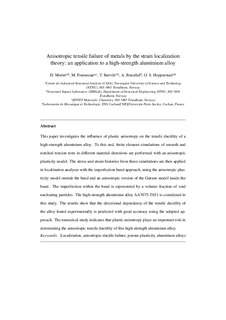| dc.contributor.author | Morin, David | |
| dc.contributor.author | Fourmeau, Marion | |
| dc.contributor.author | Børvik, Tore | |
| dc.contributor.author | Benallal, Ahmed | |
| dc.contributor.author | Hopperstad, Odd Sture | |
| dc.date.accessioned | 2019-02-19T08:55:03Z | |
| dc.date.available | 2019-02-19T08:55:03Z | |
| dc.date.created | 2018-07-09T12:32:14Z | |
| dc.date.issued | 2018 | |
| dc.identifier.citation | European journal of mechanics. A, Solids. 2018, 69 99-112. | nb_NO |
| dc.identifier.issn | 0997-7538 | |
| dc.identifier.uri | http://hdl.handle.net/11250/2586111 | |
| dc.description.abstract | This paper investigates the influence of plastic anisotropy on the tensile ductility of a high-strength aluminium alloy. To this end, finite element simulations of smooth and notched tension tests in different material directions are performed with an anisotropic plasticity model. The stress and strain histories from these simulations are then applied in localization analyses with the imperfection band approach, using the anisotropic plasticity model outside the band and an anisotropic version of the Gurson model inside the band. The imperfection within the band is represented by a volume fraction of void nucleating particles. The high-strength aluminium alloy AA7075-T651 is considered in this study. The results show that the directional dependency of the tensile ductility of the alloy found experimentally is predicted with good accuracy using the adopted approach. The numerical study indicates that plastic anisotropy plays an important role in determining the anisotropic tensile ductility of this high-strength aluminium alloy. | nb_NO |
| dc.language.iso | eng | nb_NO |
| dc.publisher | Elsevier | nb_NO |
| dc.rights | Attribution-NonCommercial-NoDerivatives 4.0 Internasjonal | * |
| dc.rights.uri | http://creativecommons.org/licenses/by-nc-nd/4.0/deed.no | * |
| dc.title | Anisotropic tensile failure of metals by the strain localization theory: An application to a high-strength aluminium alloy | nb_NO |
| dc.title.alternative | Anisotropic tensile failure of metals by the strain localization theory: An application to a high-strength aluminium alloy | nb_NO |
| dc.type | Journal article | nb_NO |
| dc.type | Peer reviewed | nb_NO |
| dc.description.version | acceptedVersion | nb_NO |
| dc.source.pagenumber | 99-112 | nb_NO |
| dc.source.volume | 69 | nb_NO |
| dc.source.journal | European journal of mechanics. A, Solids | nb_NO |
| dc.identifier.doi | 10.1016/j.euromechsol.2017.11.015 | |
| dc.identifier.cristin | 1596352 | |
| dc.relation.project | Norges forskningsråd: 250553 | nb_NO |
| dc.description.localcode | © 2017. This is the authors’ accepted and refereed manuscript to the article. Locked until 15.12.2019 due to copyright restrictions. This manuscript version is made available under the CC-BY-NC-ND 4.0 license http://creativecommons.org/licenses/by-nc-nd/4.0/ | nb_NO |
| cristin.unitcode | 194,64,45,0 | |
| cristin.unitname | Institutt for konstruksjonsteknikk | |
| cristin.ispublished | true | |
| cristin.fulltext | postprint | |
| cristin.qualitycode | 1 | |

